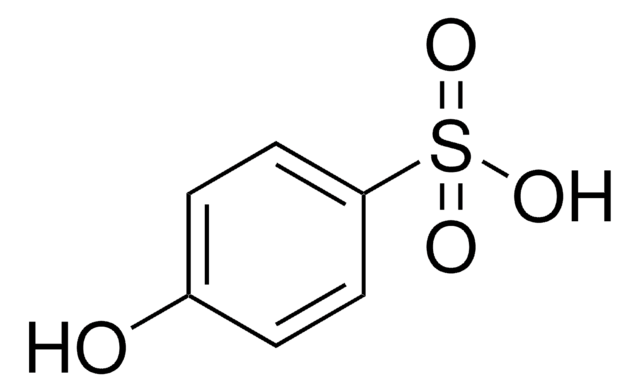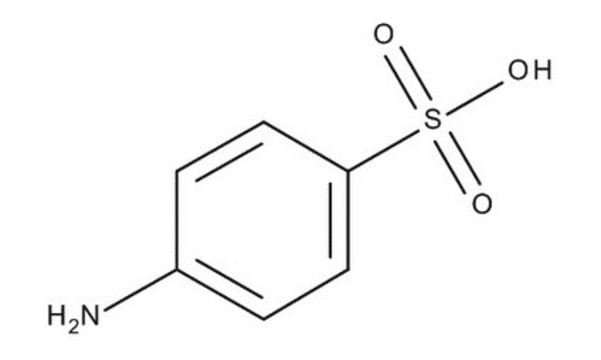추천 제품
분석
97%
형태
powder
mp
>300 °C (lit.)
solubility
ethanol: very slightly soluble(lit.)
methanol: very slightly soluble(lit.)
SMILES string
Nc1cccc(c1)S(O)(=O)=O
InChI
1S/C6H7NO3S/c7-5-2-1-3-6(4-5)11(8,9)10/h1-4H,7H2,(H,8,9,10)
InChI key
ZAJAQTYSTDTMCU-UHFFFAOYSA-N
유사한 제품을 찾으십니까? 방문 제품 비교 안내
관련 카테고리
일반 설명
3-Aminobenzenesulfonic acid undergoes microbial desulfonation to 3-aminophenol by Pseudomonas sp. strain S-313.
애플리케이션
3-Aminobenzenesulfonic acid was used in the synthesis of cytocompatible sulfonated polyanilines. It was used in fabrication of novel glucose biosensor having large active surface area and excellent conductivity.
신호어
Warning
유해 및 위험 성명서
Hazard Classifications
Acute Tox. 4 Dermal - Acute Tox. 4 Inhalation - Acute Tox. 4 Oral
Storage Class Code
13 - Non Combustible Solids
WGK
WGK 1
Flash Point (°F)
Not applicable
Flash Point (°C)
Not applicable
개인 보호 장비
dust mask type N95 (US), Eyeshields, Gloves
시험 성적서(COA)
제품의 로트/배치 번호를 입력하여 시험 성적서(COA)을 검색하십시오. 로트 및 배치 번호는 제품 라벨에 있는 ‘로트’ 또는 ‘배치’라는 용어 뒤에서 찾을 수 있습니다.
이미 열람한 고객
Simon Doswald et al.
Chemistry (Weinheim an der Bergstrasse, Germany), 27(12), 4108-4114 (2020-12-23)
The functionalization of magnetic nanoparticles has been an important field in the last decade due to the versatile applications in catalysis and biomedicine. Generally, a high degree of functionalities on the surface of the nanoparticles is desired. In this study
D Zürrer et al.
Applied and environmental microbiology, 53(7), 1459-1463 (1987-07-01)
Sulfur-limited batch enrichment cultures containing one of nine multisubstituted naphthalenesulfonates and an inoculum from sewage yielded several taxa of bacteria which could quantitatively utilize 19 sulfonated aromatic compounds as the sole sulfur source for growth. Growth yields were about 4
Mei-Hwa Lee et al.
Biosensors & bioelectronics, 150, 111901-111901 (2019-11-27)
Molecularly imprinted polymers (MIPs) have been developed to replace antibodies for the recognition of target molecules (such as antigens), and have been integrated into electrochemical sensing approaches by polymerization onto an electrode. Electrochemical sensing is inexpensive and flexible, and has
Yanyin Yang et al.
Macromolecular rapid communications, 32(12), 887-892 (2011-05-19)
We report here that by good design, polyaniline (PANI) can be cytocompatible and formed into usable scaffolds for bio-medical applications. By adjusting the ratio of two monomers, aniline (AN) and metanilic acid (MA), a series of copolymers with different sulfonation
Kai-Hsi Liu et al.
Biosensors, 10(3) (2020-03-04)
Molecularly imprinted polymers (MIPs) can often bind target molecules with high selectivity and specificity. When used as MIPs, conductive polymers may have unique binding capabilities; they often contain aromatic rings and functional groups, which can undergo π-π and hydrogen bonding
자사의 과학자팀은 생명 과학, 재료 과학, 화학 합성, 크로마토그래피, 분석 및 기타 많은 영역을 포함한 모든 과학 분야에 경험이 있습니다..
고객지원팀으로 연락바랍니다.









